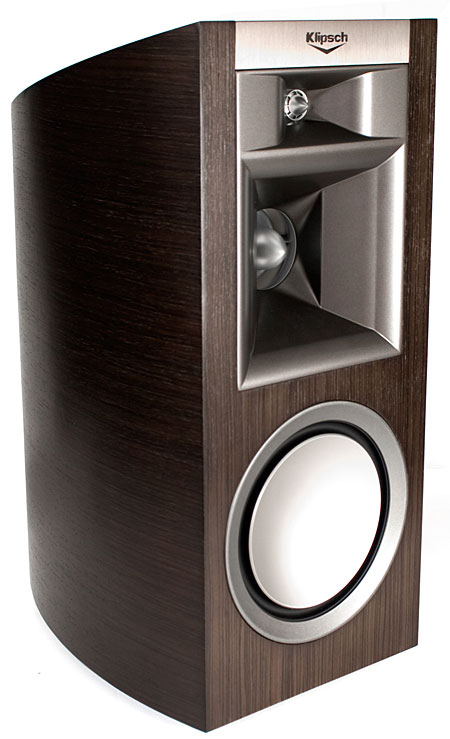| Columns Retired Columns & Blogs |
Klipsch Palladium P-17B loudspeaker Page 2
With the enormous care shown in every aspect of the P-17B's design, and considering its price of $4000/pair, it's unfortunate that Klipsch has not designed for it—let alone included—a proprietary stand. Klipsch should at least partner with another manufacturer to create a stand that will bring out this speaker's best, support it securely, and complement its gorgeous design.
Once I'd got the P-17Bs sitting atop my dowdy stands, I discovered that positioning them in my room was also a little trickier than usual. As with any pair of speakers, the P-17Bs' imaging and tonal balance were affected by their degree of toe-in, but perhaps this horn model was a bit more sensitive in this regard than other speakers I've used. The P-17B was so revealing that I easily heard a difference with every 5° increment of toe-in angle. I got the best results when staring straight down the barrels of the midrange horns. This meant that I had to push the speakers a bit farther apart, and closer to my sidewalls, than is usual for my room. Their final positions produced a remarkably wide and extremely stable lateral soundstage, with a tonal balance that had just the right amount of midbass warmth and low-bass thump. Here, the P-17Bs sounded much larger and more authoritative than their size might indicate.

I don't want my setup saga to imply that the P-17Bs were finicky about placement—they actually sounded quite good wherever I placed them—but these speakers will amply reward those who take the time to fine-tune their positions.
The P-17Bs' break-in period was typical. In the first 100 hours of playing I found their tonal balance a bit on the thin, bright side. In the second 100 hours the sound warmed up, with more flesh in the midrange and more body in the bass. After about 300 hours, the speakers settled into their final, well-balanced sound.
I tried the Klipsches with a number of different amplifiers, but found that they worked best with both of the solid-state Pass Labs amps I had, the Aleph 3 and XA 30.5, as well as Rogue Audio's M180 tube monoblocks.
What's with all these new bands with animal names?
I'm used to listening to full-range speakers at my house, and the smaller Klipsch required a bit of an adjustment period—at first, I missed hearing the last, bottom octave from the Palladium P-17B. However, my ears quickly adjusted to the new sound, and I began hearing the remarkable job the P-17B was doing with the bass. Listening to the low-bass warble tones on Editor's Choice (CD, Stereophile STPH016-2), I found that I got useful output down to about 45Hz in my room. Unlike with many small speakers, I heard little to no bloat, thickness, or upper-bass emphasis from the P-17B. Many designers emphasize the mid- and upper bass to make a small speaker sound as if it's producing more bass than it actually is. This is a neat trick, but I've found that, after a while, I wise up to the illusion, and soon long for a flatter, more honest bass response.
The P-17B's taut and speedy bass was especially handy when listening to "Fit Song," by Japanese electronic musician Cornelius, from his album Sensuous (CD, Warner Bros. EVE016). This track features powerful, well-recorded kick-drum beats set against tons of split-second samples and effects. The Klipsch loved this track—its bass, though not bowel-loosening, had great weight and fantastic slam. Yes, my Revel Performa F30s sock my gut deeper and harder than did the Klipsches, but they also sound a bit more sluggish than the P-17Bs. Male voices got honest and full-bodied treatment from the Palladiums. Johnny Cash's recording of "Flesh and Blood," from Cash Unearthed (CD, American B0001679-02), was a song I included on gift mix CDs I made for my wedding last October. Through the P-17B, Cash's voice had just the right amounts of warmth and heft, without the thickness that many speakers impart to this track. Beautiful is not a word often associated with Johnny Cash's singing, but I think it applies to his work on this track, especially through the Klipsches.
Horn-loaded tweeters can give me the heebie-jeebies—just the thought of all those horn resonances and hard reflections near a tweeter scare the liver out of me. However, after the break-in period, the Klipsch's tweeter proved to be among the smoothest, most shimmery I've heard in my home. Most important, it never sounded like a horn. In fact, it reminded me more of a ribbon tweeter than the ¾" metal dome it is. On naturally recorded music, such as the Tokyo Quartet's superb CD of the Ravel and Debussy string quartets (CD, RCA Victor Red Seal 62552-2), the P-17B's tweeter sounded lively, open, and airy, rendering every pizzicato pluck, every slightest noise of horsehair drawn across steel strings, and the way the overtones of violin ring throughout a concert hall. It was totally beguiling.
The P-17B's tweeter may have been a bit too airy. It seemed to blend incredibly well with the midrange driver, sounding very neutral through the low and mid-treble, then rose slightly in response through the 11–15kHz range. A hot response in this band doesn't usually result in a hard-sounding treble; instead, it adds the feeling and sound of "air" around instruments. Many older listeners may welcome the way the P-17B did treble—it could add back a little of the high-frequency range that time has taken from their ears. However, since many pop engineers and producers already overcook these frequencies—the ubiquitous +10dB bump at 10kHz given most pop vocals comes to mind—sometimes the Klipsch gave me too much of a good thing.
- Log in or register to post comments




































